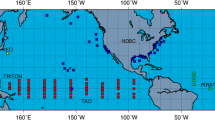Abstract
In 2006, the National Meteorological Information Center (NMIC) of the China Meteorological Administration (CMA) developed its real-time quality control (QC) system of rawinsonde observations coming from the Global Telecommunications System (GTS) and established the Global Upper-air Report Dataset, which, with the NMIC B01 format, is generally referred to as the B01 dataset and updated on a daily basis. However, when the B01 dataset is applied in climate analysis, some wind errors as well as some accurate values with incorrect error marks are found. To improve the quality and usefulness of Chinese rawinsonde wind observations, a new QC method (NewQC) is proposed in this paper. Different from the QC approach used for B01 datasets, the NewQC includes two vertical-wind-shear checks to analyze the vertical consistency of winds, in which the constant height level winds are used as reference data for the QC of mandatory pressure level winds. Different threshold values are adopted in the wind shear checks for different stations and different vertical levels. Several typical examples of QC of different error types by the new algorithm are shown and its performance with respect to 1980-2008 observational data is statistically evaluated. Compared with the radiosonde QC algorithms used in both the Meteorological Assimilation Data Ingest System (MADIS, http://madis.noaa.gov/madis_raob_qc.html) of the National Oceanic and Atmospheric Administration (NOAA) and the B01 dataset, the NewQC shows higher accuracy and better reliability, particularly when used to judge successive observation errors.
Similar content being viewed by others
References
Alduchov, O. A., and R. E. Eskridge, 1996: Complex quality control of upper-air variables: Geopotential height, temperature, wind and humidity at mandatory and significant levels. NCDC Report. 146 pp. [Available from NCDC, 151 Patton Ave., Asheville, NC 28801-5001; NTIS PB97-132286.]
Anderson, E., and H. Järvinen, 1999: Variational quality control. Quart. J. Roy. Meteor. Soc., 125(554), 697–722.
Baker, N. L., 1992: Quality control for the navy operational atmospheric database. Wea. Forecasting, 7(2), 250–261.
CMA, 1976: Upper-air meteorological observation manual. China Meteorological Administration, Beijing, 51–76. (in Chinese)
CMA, 2010: Conventional Upper-air Meteorological Observation Standard. China Meteorological Press, Beijing, 10–14. (in Chinese)
Ciesielski, P. E., and Coauthors, 2010: Quality-controlled upperair sounding dataset for TiMREX/SoWMEX: Development and corrections. J. Atmos. Oceanic Technol., 27(11), 1802–1821.
DiMego, G. J., P. A. Phoebus, and J. E. McDonnel, 1985: Data processing and quality control for optimum interpolation analyses at the National Meteorological Center. NMC Office Note 306, NOAA, U.S. Dept. of Commerce, 8 pp.
Darling, R. W. R., 1991: Estimating probabilities of hurricane wind speeds using a large-scale empirical model. J. Climate, 4(10), 1035–1046.
Eskridge, R. E., O. A. Alduchov, I. V. Chernykh, P. Zhai, A. C. Polansky, and S. R. Doty, 1995: A Comprehensive Aerological Reference Data Set (CARDS): Rough and systematic errors. Bull. Amer. Meteor. Soc., 76(10), 1759–1775.
Gandin, L. S., 1988: Complex quality control of meteorological observations. Mon. Wea. Rev., 116(5), 1137–1156.
Durre, I., R. S. Vose, and D. B. Wuertz, 2006: Overview of the integrated global radiosonde archive. J. Climate, 19(1), 53–68.
Ma, K. Y., Y. G. Ding, Q. P. Tu, and Z. S. Me, 1993: Climate Statistical Principle and Method. China Meteorological Press, Beijing, 393–394. (in Chinese)
Markowski, P., and Y. Richardson, 2006: On the classification of vertical wind shear as directional shear versus speed shear. Wea. Forecasting, 21(2), 242–247.
Oswald, E. M., and R. B. Rood, 2013: A trend analysis of the 1930–2010 extreme heat events in the continental U.S. J. Appl. Meteor. Climatol., 53, 565–582.
Steinacker, R., D. Mayer, and A. Steiner, 2011: Data quality control based on Self-Consistency. Mon. Wea. Rev., 139(12), 3974–3991.
WMO, 1995: Manual on codes. WMO-No. 306, World Meteorological Organization, Geneva, Switzerland. 503pp.
WMO, 2008: Guide to Meteorological Instruments and methods of observation. 7th ed., WMO Rep. 8, World Meteorological Organization, Geneva, Switzerland. 681pp.
Wang, W. L, B. M. Wang, F. H. Guo, and X. N. Liu, 2011: Quality control for radiosonde data. QX/T 123-2011, Chinese Meteorological Administration, Beijing, China.
Xiao, C. Y., X. Hu, J. C. Gong, and J. Liu. 2008: Analysis of the characteristics of the stratospheric quasi-zero wind layer over China. Chinese Journal of Space Science, 28(3), 230–235. (in Chinese)
Author information
Authors and Affiliations
Corresponding author
Rights and permissions
About this article
Cite this article
Liao, J., Wang, B. & Li, Q. A new method for quality control of Chinese rawinsonde wind observations. Adv. Atmos. Sci. 31, 1293–1304 (2014). https://doi.org/10.1007/s00376-014-4030-6
Received:
Revised:
Accepted:
Published:
Issue Date:
DOI: https://doi.org/10.1007/s00376-014-4030-6




